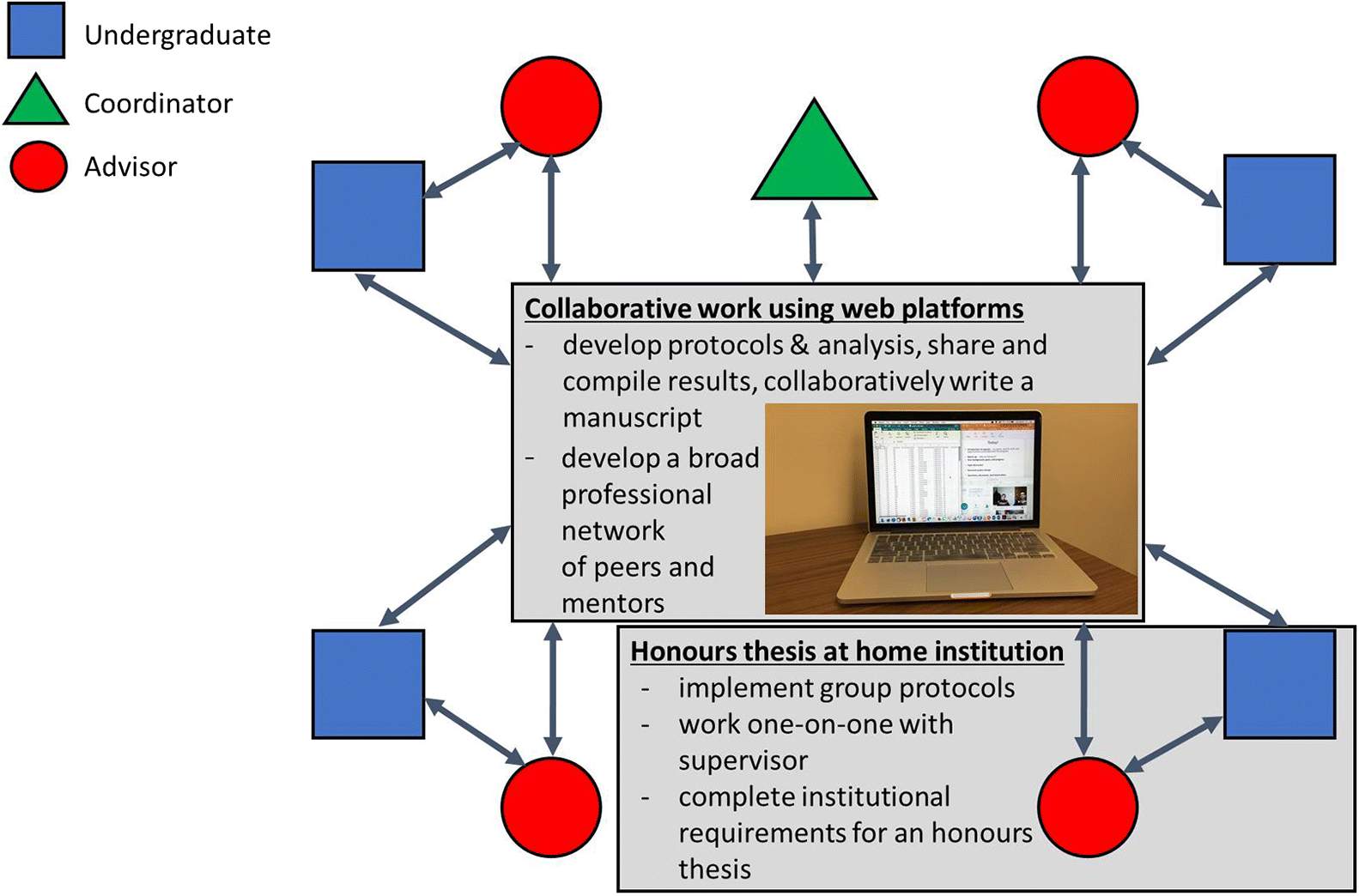A model for training undergraduate students in collaborative science
Abstract
Introduction
| Typical one-on-one supervisory model | Collaborative model | |||
|---|---|---|---|---|
| Skill type | Learning objective | Activity | Learning objective | Activity |
| Intellectual | T1 | Define research questions and devise and evaluate approaches to answering them | C1 | Develop skills for online collaboration, scientific discussion, and brainstorming |
| T2 | Critically evaluate scientific literature and other sources of information | C2 | Use tools for sharing literature and collaborative writing | |
| T3 | Place work appropriately in the context of relevant scientific literature | C3 | Build skills for understanding and communicating the credibility of information sources | |
| Practical | T4 | Plan, conduct, and present a research project | C4 | Develop and refine protocols collaboratively |
| T5 | Develop specialized field and lab skills, depending on the specific project | C5 | Implement protocols in a consistent way across researchers | |
| C6 | Communicate with collaborators about challenges or modifications to the protocols | |||
| Communication | T6 | Communicate the context and results of a project through a written thesis | C7 | Incorporate feedback from a range of collaborators |
| T7 | Communicate the context and results of a project through an oral presentation | C8 | Develop the ability to give useful and appropriate feedback to collaborators | |
| C9 | Use a variety of online presentation and discussion tools suited to specific needs | |||
| Numeracy | T8 | Prepare, process, and interpret your own data | C10 | Develop common data management frameworks, metadata standards, and appropriate sharing and version control procedures |
| T9 | Perform basic statistical analyses using appropriate software | C11 | Collaboratively develop statistical approaches, and share code and results | |
| Personal and career development | T10 | Develop personal skills necessary to conduct research, such as time management and organizational skills | C12 | Move from personal use of social media and other online resources to professional use |
| T11 | Cultivate a relationship with a faculty mentor who can provide career advice and references | C13 | Share experiences, goals, and challenges in developing key skills for the workplace | |
| C14 | Build professional relationships online with researchers outside the home institution | |||
Network design

| Theme | Learning objectives | Online and remote collaborative activities |
|---|---|---|
| Intellectual | ||
| Literature searches | T2, T3, C2, C3 | Guided “scavenger hunt” activity introducing the basics of using Web of Science |
| Experimental design and hypothesis testing | T8, T9, C10, C11 | Brainstorming and constructing hypotheses |
| Practical | ||
| Protocol implementation | T4, C4, C5 | Attempt, discuss, and revise the scaffolded experimental protocol |
| Data management | C10, C11 | Build common data file template, use for data sharing/synthesis |
| Lab skills, QA/QC | C4, C5, C6, C10 | Online discussion of QA/QC and document successes and challenges |
| Communication | ||
| Thesis writing styles/tools | T3, T6, C2, C3, C7, C8 | Collaborative introduction writing and revision according to advisor feedback |
| Peer-review methods exchange | ||
| Oral/visual presentations | T4, T7, C9 | Provide a synopsis of study sites |
| Numeracy | ||
| R intro, data visualization basics | T8, T9, C10, C11 | Jigsaw—students present on statistical analyses and their use |
| Making sense of results, sharing results | T7, C11 | Presenting results via web conference |
| Code sharing | ||
| Personal and career development | ||
| Collaborative science | T1, C1, C4, C9, C12 | Discussion of goals for the project, and implementation of shared online tools |
| Mid-project check-in | C12, C13, C14 | Discussion of progress on the project and changes to be made or new skills to work on |
| Network results and wrap-up | T11, C13, C14 | Career options and strategies |
Note: QA, quality assurance; QC, quality control.
Program review
Advantages of the network
Student perspectives
Faculty perspectives
Recommendations for network enhancement and adaptation
Conclusions
Acknowledgements
References
Information & Authors
Information
Published In

History
Copyright
Data Availability Statement
Key Words
Sections
Subjects
Plain Language Summary
Authors
Author Contributions
Competing Interests
Metrics & Citations
Metrics
Other Metrics
Citations
Cite As
Export Citations
If you have the appropriate software installed, you can download article citation data to the citation manager of your choice. Simply select your manager software from the list below and click Download.
